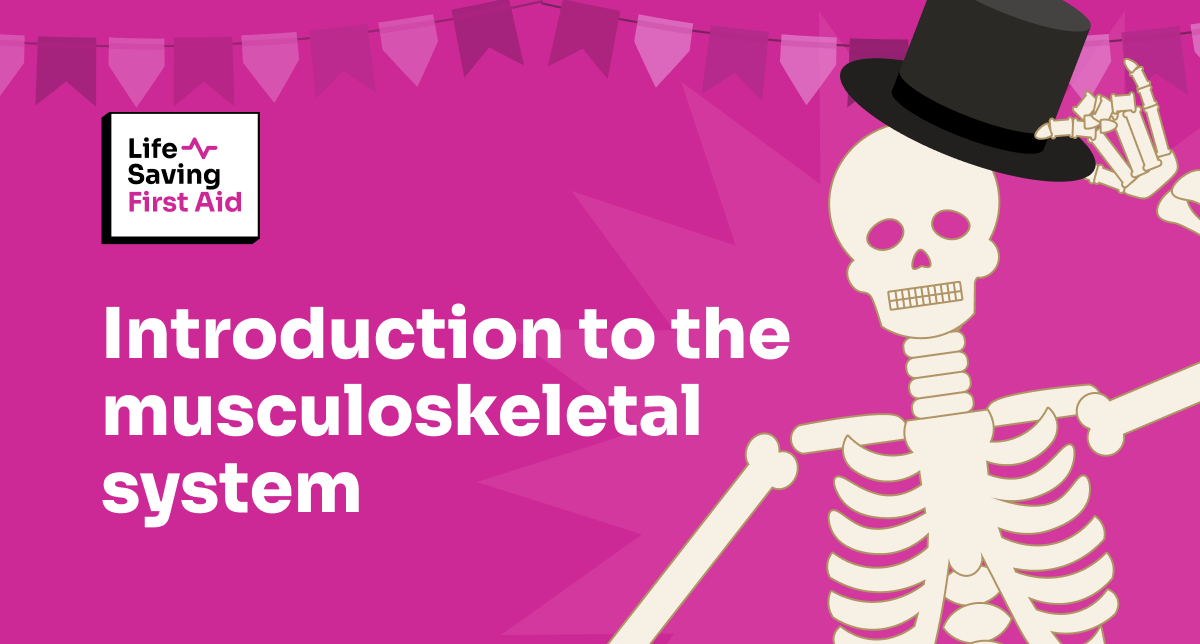Introduction to the musculoskeletal system
As a first aider, you should have at least a basic understanding of how the musculoskeletal system works. Bones and muscles are the heavy lifters when it comes to moving, standing still and even keeping us alive. Some muscles we can control, some function without our conscious input.
Can you imagine what we would look like as a species if we had no skeleton? No bones in our bodies?
Let’s start with the Skeletal System
The Skeletal system
The skeletal system – sometimes referred to as the Musculoskeletal System – consists of Bones, Ligaments, Tendons, and Joints.
The major functions of the skeletal system are:
- Body support,
- Facilitation of movement,
- Protection of internal organs,
- Storage of minerals and fat,
- Support the production and replenishment of blood for the body
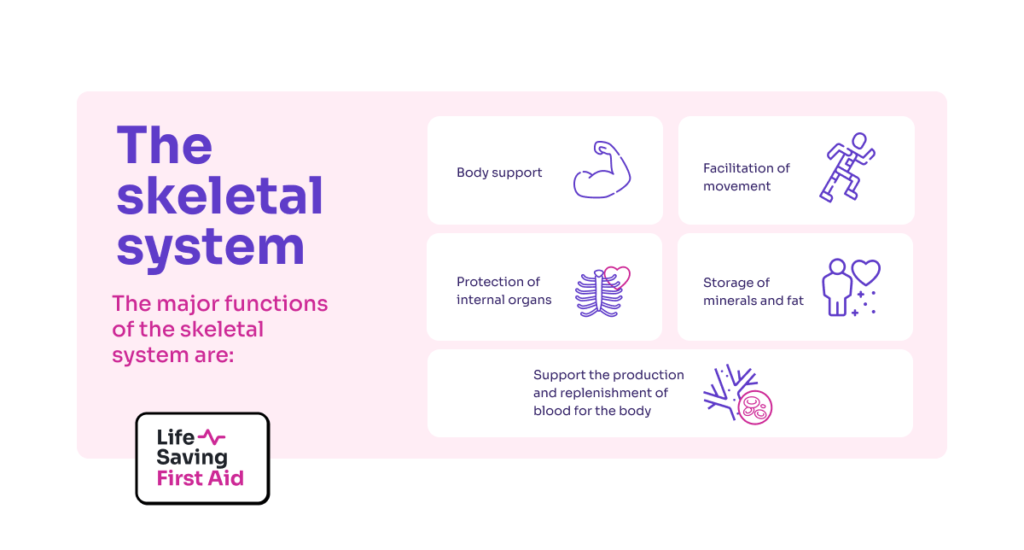
Skeletal system – Bones
The adult human skeletal system has 206 bones, joined together by Joints, Ligaments, and Tendons.
Bones are a rigid form of connective tissue. Composed principally of calcium, they support the body and protect the organs. The bones also provide a surface for muscles to attach to.
A baby’s body has about 300 bones at birth. These eventually grow together to form the 206 bones that adults have. Some of a baby’s bones are made entirely of cartilage while others are partly made of cartilage. This cartilage is soft and flexible. During childhood, as a person grows, the cartilage grows and is slowly replaced by bone, with help from calcium.
Therefore, for example, when performing CPR on an Infant we use only 2 fingers, or one hand for a child, and press down with less effort. Their bones are much more flexible than adults.
Older people are more likely to suffer from osteoporosis, which affects their bones. Their bones may become more brittle and break easily, or less dense and therefore not as strong. In fact, their entire Musculoskeletal system may be weaker and less robust than a young person.
Ligaments
Ligaments are bands of tough elastic tissue around your joints. They connect bone to bone, give your joints support, and limit their movement. You have ligaments around your knees, ankles, elbows, shoulders, and other joints.
Tendons
Tendons are tough, flexible, and inelastic bands of fibrous connective tissue that connect muscles to bones.
Joints
The joints connect bone to bone, and there are 360 joints in our bodies. Joints hold the skeleton and support movement. We group joints together by their function and structure. The types of joints are ball-and-socket, hinge, and pivot joints.
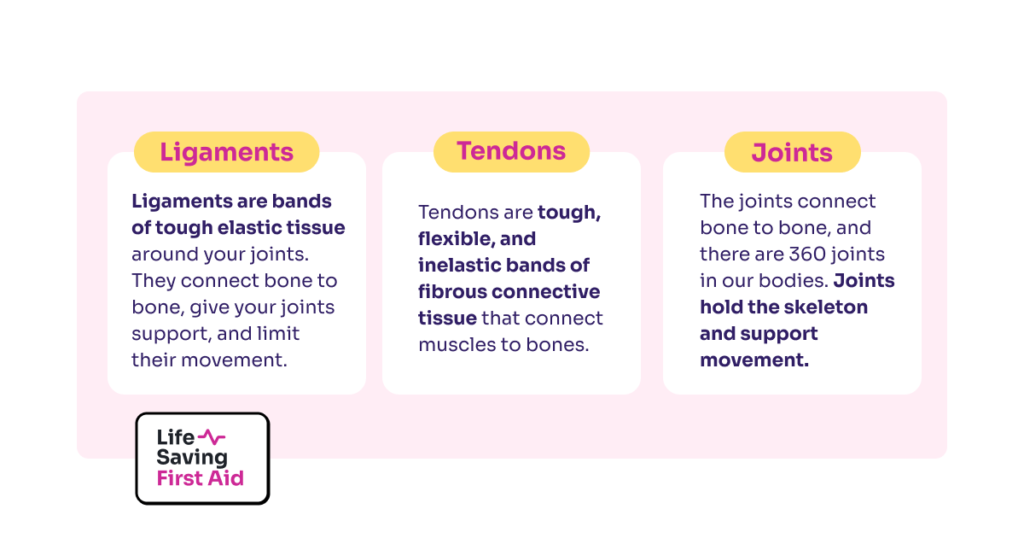
Three kinds of freely movable joints play a big part in voluntary movement:
- Hinge joints – allow movement in one direction, as seen in the knees and elbows.
- Pivot joints – allow a rotating or twisting motion, like that of the head moving from side to side.
- Ball-and-socket joints – where the round end of a long bone fits into the hollow of another bone allow the greatest freedom of movement. The hips and shoulders have this type of joint.
Tendons and ligaments keep the Musculoskeletal system joined together, working with the joints to support movement.
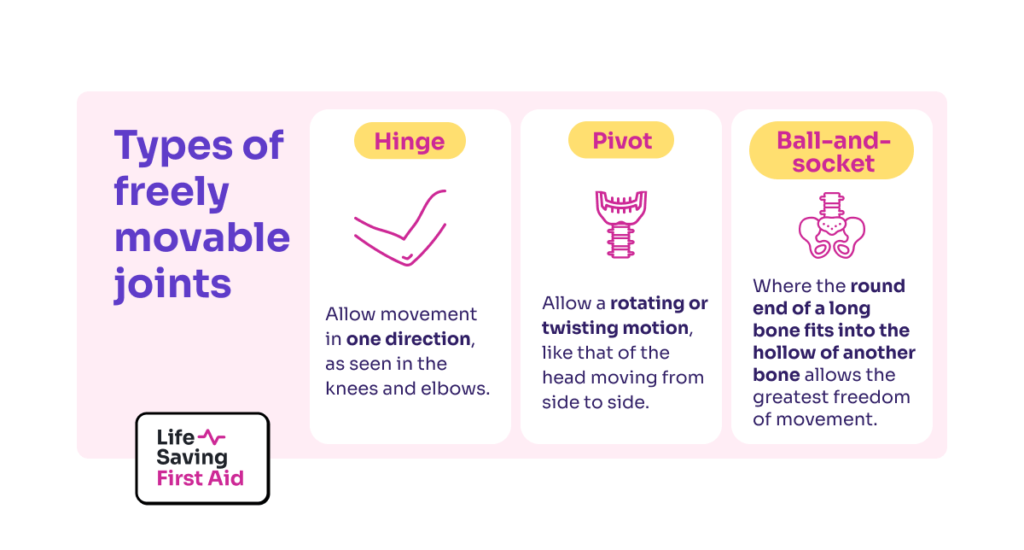
Skeletal system problems for the first aider
For a first aider problems with bones include:
- Fractures – when a bone is broken
- Dislocations – where two bones have separated at a joint
- Spinal Injuries – severed spinal cord
- Skull injuries – fractured or punctured
- Sprains – where the ligaments that connect and stabilise the bones in a joint are stretched or torn
According to Healthy Bones Australia, in 2022, it is estimated there will be 6.2 million Australians over the age of 50 with osteoporosis or osteopenia – commonly seen in people over age 50 who have lower than average bone density but do not have osteoporosis. Osteoporosis is rare in children and adolescents.
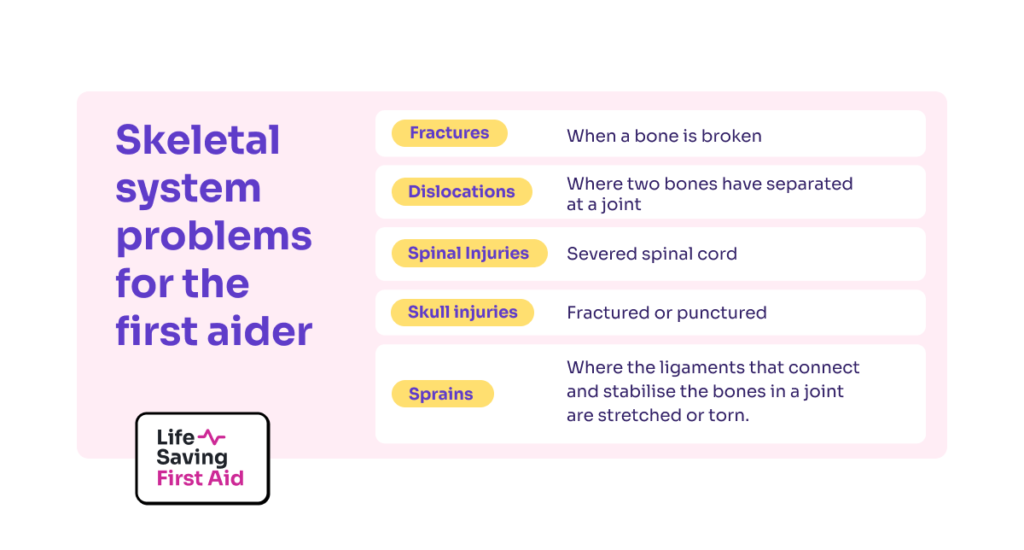
Muscles
Included in the Musculoskeletal system are the muscles. There are about 600 muscles in the human body; the three main types of muscle are skeletal, smooth, and cardiac.
A muscle is made up of thousands of elastic fibres bundled tightly together. Each bundle is wrapped in a thin transparent membrane called a perimysium.
Skeletal muscles are the most common muscles in the body as they move the bones. They play a vital role in everyday activities. Skeletal muscles are also responsible for generating heat in the body to maintain body temperature and help regulate blood sugar levels.
Skeletal muscle (voluntary muscle or striated muscle) is the muscle that you can consciously control. Skeletal muscles run from one bone to another, usually passing at least one joint.
Skeletal muscle injuries or diseases can profoundly affect a person’s life.
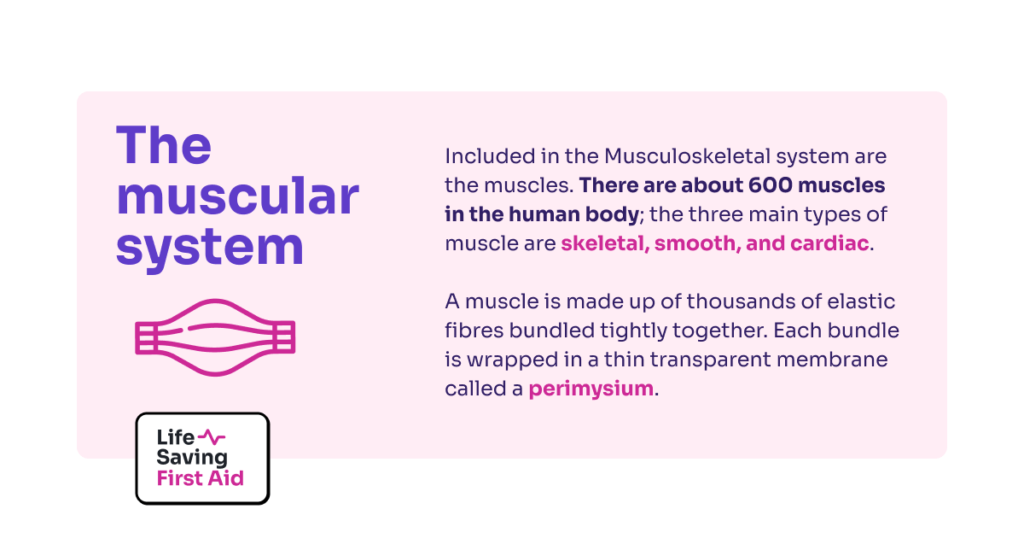
Smooth Muscle
Smooth muscle is present throughout the body, where it serves a variety of functions.
Found in the blood vessels such as arteries assisting the heart in moving blood around the body. In the stomach and intestines, smooth muscle helps with digestion and the collection of nutrients. It exists throughout the urinary system, where it functions to help rid the body of toxins and works in electrolyte balance.
Cardiac
Cardiac muscle differs from skeletal muscle in that it exhibits rhythmic contractions and is not under voluntary control. Rapid, involuntary contraction and relaxation of the cardiac muscle are vital for pumping blood throughout the cardiovascular system. To accomplish this, the structure of cardiac muscle has distinct features that allow it to contract in a coordinated fashion and resist fatigue.
Voluntary and involuntary muscles.
As you can see, muscles have a range of functions from pumping blood and supporting movement to lifting heavy weights.
Muscle movement made consciously is called voluntary. Involuntary muscle movement is a movement made without conscious awareness.
Generally, any movement of the Musculoskeletal system is voluntary. Skeletal muscles work in pairs. As a result, if your brain signals a muscle to contract, it shortens, pulling one bone towards another across a joint. When one shortens, a corresponding muscle lengthens.
A good example of this action is your upper arm. As you contract your bicep on the front of your upper arm, your tricep on the back of your upper arm lengthens. And vice versa.
Involuntary muscles on the other hand operate without conscious thought or input. Smooth muscle inside blood vessels and organs like the intestines for example. It contracts to move substances through the organ, and so helps regulate your blood pressure, airways, and digestion.
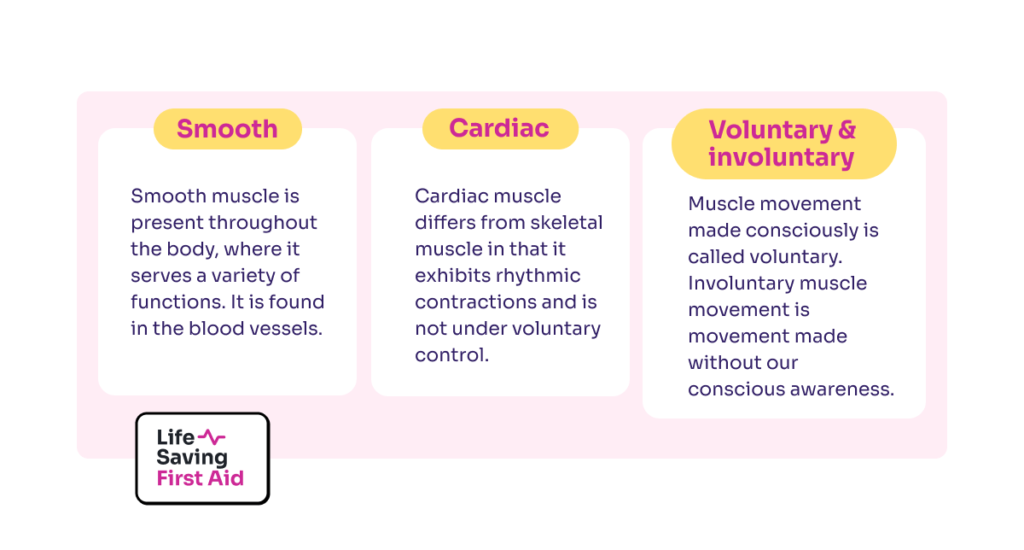
Muscle problems for the first aider
Some of the more common muscle problems for a first aider include
- Strains – where the muscle is over-stretched or contracted too quickly, leading to a partial or complete tear of the muscle fibres or the tendon
- Muscle cramps – These sudden contractions of a muscle can be very painful
- Tendonitis – inflammation or irritation of a tendon, the fibrous cord that attaches a muscle to the bone
For how to deal with soft tissue injuries check out our post ” Ricer. Initial first aid action plan for sprains and strains”
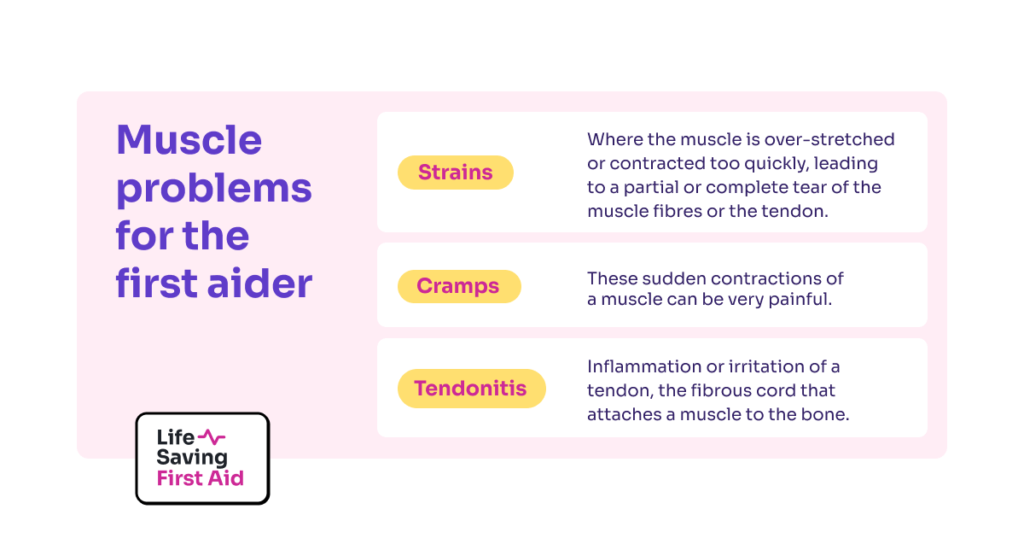
Points to remember:
- The Musculoskeletal system comprises the muscles, skeleton, tendons, and ligaments
- Some muscles operate automatically without conscious input from us
- Most body movement requires conscious input from our brain
- The Musculoskeletal system is prone to injury and requires first aid or more advanced medical care
- There is a difference in the strength of the system depending on the age of the person
Well, that’s that. Until next time… Stay safe.
